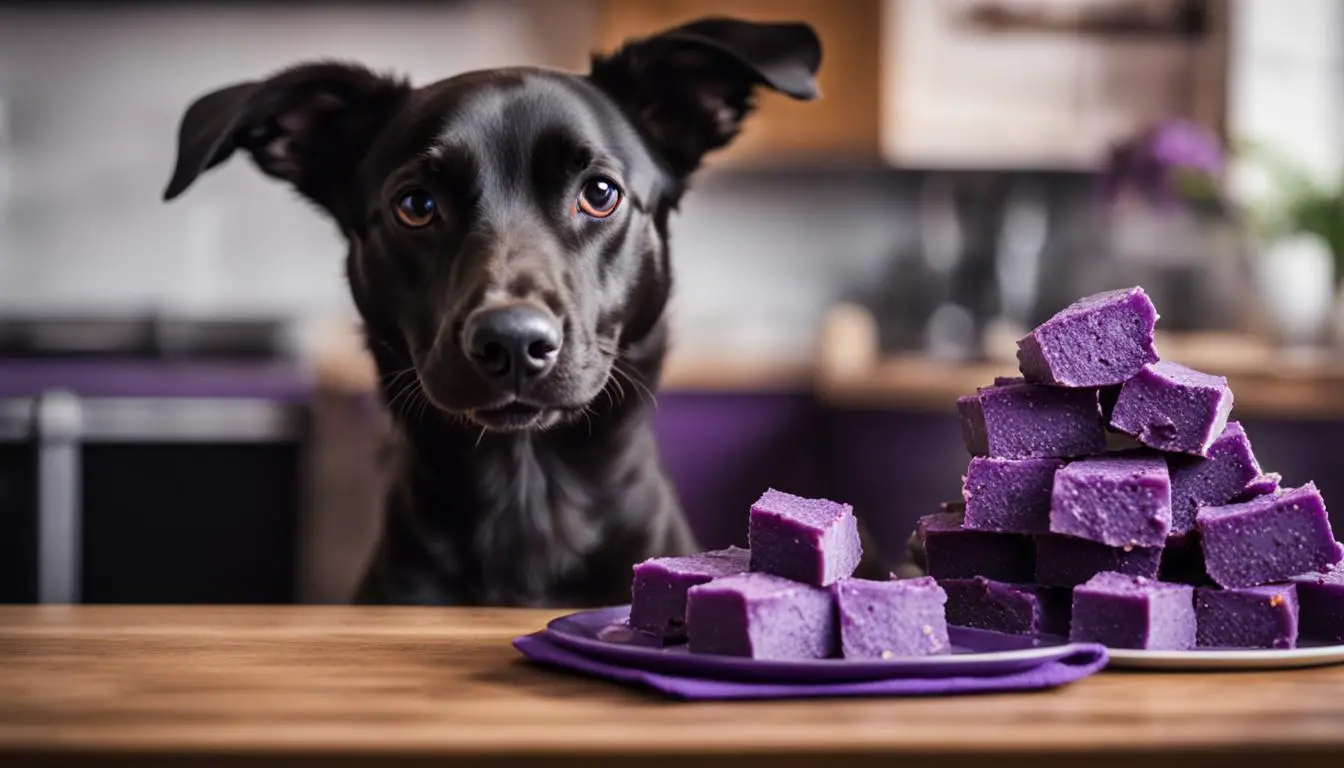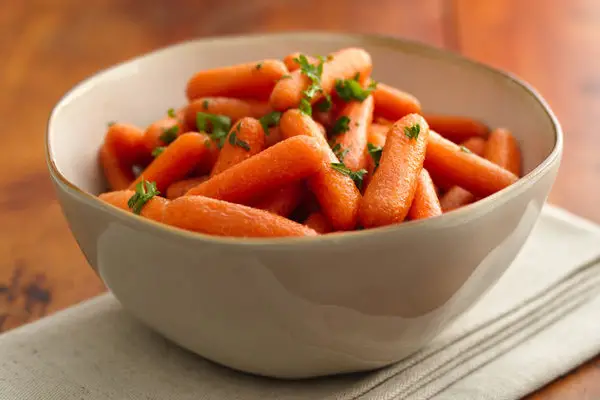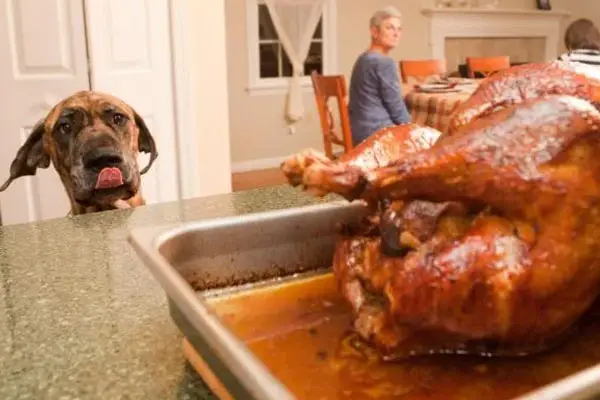Can Dogs Eat Ube? Discover the Colorful World of This Tasty Delight!
Are you curious about sharing the delightful world of purple yam or Ube with your furry friend? Can Dogs Eat Ube? We all love treating our dogs, but ensuring their safety and health is crucial.
Join us in this quick read as we uncover whether dogs can indulge in this colorful and tasty delight. We’ve got you covered, From potential risks and benefits to understanding the nutritional value. Let’s explore the possibilities of responsibly adding Ube to your dog’s diet!
Understanding Ube: What You Need to Know
Ube, also known as purple yam, is a root vegetable widely consumed in Southeast Asian cuisines and desserts. Its vibrant purple color makes it visually appealing, and its naturally sweet and earthy flavor adds a unique taste to various dishes. In traditional cuisines, Ube is a critical ingredient in popular desserts like Ube halaya, ice cream, and cakes.
The versatility of Ube allows it to be incorporated into both sweet and savory recipes, making it a favorite ingredient in the culinary scene worldwide. Its popularity has grown, and many people enjoy the taste and nutritional benefits of Ube.
To give you a better idea of the nutritional composition of Ube, here is a table highlighting its essential nutrients:
| Nutrient | Amount per 100g |
|---|---|
| Calories | 103 |
| Carbohydrates | 27.6g |
| Fiber | 4g |
| Protein | 1.4g |
| Fat | 0.2g |
| Potassium | 816mg |
| Vitamin A | 435 IU |
| Vitamin C | 2.4mg |
| Manganese | 0.2mg |
The Health Benefits of Ube for Dogs
Ube, or purple yam, is a healthy dog, packed with vital vitamins and minerals. Its high levels of vitamins A and C support eye health, a robust immune system, and overall well-being.
Additionally, Ube provides potassium for a healthy heart and muscles and manganese for bone health and metabolism. The fiber content in Ube aids in maintaining digestive health, ensuring regular bowel movements, and preventing constipation in dogs.
Benefits of Ube for Dogs:
- High in vitamins A and C, promoting eye health and a strong immune system.
- Rich in potassium, supporting a healthy heart and muscle function.
- Contains manganese, promoting bone health and metabolism.
- Fiber content aids in digestive health, regulating bowel movements.
Considerations:
While Ube offers health benefits, it’s essential to be aware of potential risks and considerations when feeding it to your dog. Ube contains oxalates, which can be harmful in large amounts and may lead to oxalate toxicity, potentially causing kidney stones or obstructions.
Some dogs may also have allergic reactions to Ube or other ingredients commonly found in Ube-based foods. Introducing new foods like Ube into a dog’s diet can cause gastrointestinal disturbances, such as diarrhea or vomiting.
Additionally, Ube is relatively high in calories and carbohydrates, so it’s crucial to moderate its consumption to prevent weight gain and dog obesity.
| Benefits | Considerations |
|---|---|
| High in vitamins A and C | Potential allergic reactions |
| Rich in potassium | Gastrointestinal disturbances |
| Contains manganese | Oxalate toxicity |
| Fiber content aids in digestion | Potential weight gain |
Potential Risks and Considerations of Feeding Ube to Dogs
Ube can be suitable for dogs, but remember that each dog is different, so be cautious about potential risks.
Here are some factors to consider before introducing Ube into your dog’s diet:
Oxalate Toxicity: Ube contains oxalates, which can pose a risk if consumed in large quantities. Oxalate toxicity can lead to the formation of kidney stones or obstructions in some dogs. It’s crucial to moderate the amount of Ube your dog consumes and consult with a veterinarian if you have any concerns.
Allergic Reactions: Like humans, dogs can have allergies to certain foods. Some dogs may have allergic reactions to Ube or other ingredients commonly found in Ube-based foods.
Introducing Ube to your dog’s diet gradually, starting with small amounts, and observing their reaction closely is advisable. If any signs of allergies, such as itching, swelling, or gastrointestinal distress, occur, discontinue feeding Ube and seek guidance from a veterinarian.
Gastrointestinal Disturbances: Introducing new foods into a dog’s diet can sometimes lead to gastrointestinal disturbances. Some dogs may experience diarrhea, vomiting, or an upset stomach when fed Ube.
To minimize these risks, feed small portions of cooked and mashed Ube and monitor your dog’s response. If any digestive issues persist or worsen, discontinue providing Ube and consult with a veterinarian.
Weight Gain: Ube can be rich in calories and carbohydrates, potentially leading to weight gain if not eaten in moderation. To maintain a healthy balance, be mindful of your dog’s overall calorie intake and adjust their diet accordingly. If your dog tends to gain weight quickly, it’s advisable to restrict their Ube intake or explore alternative low-calorie treats.
Table: Comparing Ube to Other Root Vegetables
| Root Vegetable | Nutritional Benefits | Potential Risks |
|---|---|---|
| Ube | High in vitamins A and C, potassium, and manganese. Fiber content aids in digestive health. | Oxalate toxicity in large amounts. Some dogs may have allergic reactions or experience gastrointestinal disturbances. High in calories and carbohydrates, leading to weight gain if not moderated. |
| Sweet Potatoes | Rich in fiber, vitamins A and C, and antioxidants. Supports a healthy immune system and aids in digestion. | Potential for digestive upset if not cooked properly. High in carbohydrates, so portion control is essential. |
| Carrots | Good source of vitamins A and K, as well as beta-carotene. Promotes eye health and supports a healthy immune system. | Possibility of choking if not cut into appropriate sizes. Excessive consumption may lead to digestive issues or an upset stomach. |
How to Safely Feed Ube to Your Dog
When introducing new foods like Ube to your dog, proceed gradually to monitor for any allergic or digestive reactions.
Start with small amounts of cooked and mashed Ube as a treat or mixed with their regular food. Watch for signs of itching, swelling, vomiting, or diarrhea. If your dog tolerates it well, continue incorporating Ube in moderation.
Remember, each dog is unique; consult a vet before making significant diet changes. Vets can offer guidance based on your dog’s specific needs. If issues arise, stop feeding Ube and seek professional advice.
Alongside a gradual introduction, ensure Ube is part of a balanced diet. While it provides health benefits, it shouldn’t be the main component of meals. Include a variety of safe, nutritious foods.
Monitor your dog’s overall health and weight, as excessive Ube consumption may lead to weight gain and obesity.
Table: Ube Feeding Guidelines
| Step | Guidelines |
|---|---|
| 1 | Start with small amounts of cooked and mashed Ube |
| 2 | Observe your dog for any signs of allergies or digestive concerns |
| 3 | If there are no adverse reactions, gradually increase the amount of Ube |
| 4 | Include Ube as a treat or mixed with regular food, not as the main component |
| 5 | Consult with a veterinarian before introducing Ube or any new food |
Incorporating Ube Into Your Dog’s Diet: Tips and Recipe
Incorporating Ube into your dog’s diet can provide variety and flavor to their meals. Many dog owners include small amounts of cooked and mashed Ube to enhance taste and appeal. It’s important to note that Ube should be served in moderation and as part of a balanced diet.
When adding Ube to your dog’s diet, consider the following tips:
- Introduce Ube gradually: Add a small amount of cooked and mashed Ube to your dog’s regular meal. Monitor their reaction to ensure they tolerate it well.
- Watch for allergies or digestive issues: Pay attention to any signs of allergies or gastrointestinal disturbances such as itching, diarrhea, or vomiting. Stop feeding Ube and consult with your veterinarian if any adverse reactions occur.
- Serve Ube in moderation: While Ube can offer health benefits, it is important not to overfeed it to your dog. Too much Ube can lead to weight gain and other health issues. Keep portion sizes small and balanced with other components of their diet.
To make dog-friendly Ube treats, you can try the following recipe:
| Ingredients: | Instructions: |
|---|---|
| 1/2 cup cooked and mashed Ube | Combine the cooked and mashed Ube in a mixing bowl with other dog-friendly ingredients such as plain yogurt or mashed banana. |
| Plain yogurt or mashed banana (optional) | Mix well until all the ingredients are evenly combined. |
| 1 cup whole wheat flour or oat flour | Add the flour gradually and knead the dough until it reaches a manageable consistency. |
| 1/4 cup water or unsalted chicken broth | If the dough is too dry, gradually add water or unsalted chicken broth to moisten it. |
| Preheat oven to 350°F (175°C) | Once the dough is ready, roll it to a desired thickness and cut out shapes using dog-friendly cookie cutters. |
| Bake for 15-20 minutes or until golden brown | Place the treats on a baking sheet and bake them in the oven for 15-20 minutes or until golden brown. |
The History of Feeding Ube to Dogs
The history of feeding Ube, or purple yam, to dogs is relatively new. Traditional dog diets mainly consist of meat, bones, and some plant matter, providing the necessary nutrients for their growth and overall health.
However, with the growing interest in alternative diets and homemade dog food, some dog owners have begun incorporating a variety of fruits and vegetables, including Ube, into their dogs’ diets. Not all human foods are safe for dogs; some can pose potential hazards.
Regarding the evolution of dog diets, the inclusion of Ube reflects the changing attitudes towards canine nutrition. As pet owners seek to provide a more varied and nutritionally balanced diet for their dogs, they look beyond traditional dog diets and explore options like homemade food.
The introduction of Ube can be seen as a part of this movement towards incorporating different ingredients into dog diets to enhance taste, nutritional value, and overall well-being.
However, it’s crucial to approach introducing Ube to your dog’s diet cautiously. While Ube does offer certain health benefits, it’s essential to consider your dog’s individual dietary needs and any potential allergies or sensitivities and consult with a veterinarian before making any changes to their diet.
A professional opinion can help assess the suitability of Ube for your dog and provide guidance on the appropriate quantities and preparation methods to ensure a safe and balanced diet.
The Benefits and Risks of Feeding Ube to Dogs
Evaluate the effects of incorporating Ube into your dog’s diet, weighing both positive and negative outcomes. Make well-informed decisions by understanding the benefits and risks of feeding your furry friend Ube.
| Benefits | Risks |
|---|---|
| Rich in vitamins A and C | Potential allergic reactions |
| High in potassium and manganese | Oxalate toxicity |
| Fiber content aids in digestion | Gastrointestinal disturbances |
Conclusion
Explore Ube (purple yam) responsibly as a dietary option for your dog. Consult your veterinarian before making any changes, ensuring a balanced diet tailored to your dog’s needs. Start with small amounts of Ube, monitor for adverse reactions, and continue if well-tolerated.
If issues arise, discontinue and seek professional advice. Ube should supplement, not replace, essential nutrients in your dog’s diet. Prioritize their nutritional needs and consult your veterinarian for informed decisions.
FAQ
Can dogs safely eat Ube?
Yes, dogs can safely eat Ube in moderation, but there are potential risks.
What is Ube?
Ube is a Southeast Asian root vegetable also known as purple yam.
What are the health benefits of Ube for dogs?
Ube is rich in essential vitamins such as A and C and critical minerals like potassium and manganese. These nutrients support eye health, boost the immune system, and improve overall well-being.
What are the potential risks of feeding Ube to dogs?
Ube contains oxalates, which in large amounts can lead to oxalate toxicity and potentially cause kidney stones or obstructions. Some dogs may also have allergic reactions or experience gastrointestinal disturbances.
How should I introduce Ube to my dog’s diet?
Introducing Ube gradually and observing your dog for any signs of allergies or digestive concerns is essential. Start with small amounts of cooked and mashed Ube.
Can Ube be part of a balanced diet for dogs?
Yes, Ube can be incorporated into a dog’s diet to add variety and flavor, but it should always be served in moderation and as part of a balanced diet.
Can I feed my dog Ube treats?
Yes, you can make dog-friendly Ube treats using cooked and mashed Ube. However, moderate the consumption and consider your dog’s specific dietary requirements.
Is feeding Ube to dogs a new practice?
Yes, the history of feeding Ube to dogs is relatively new. Traditional dog diets mainly comprised meat, bones, and some plant matter.
What is the conclusion on incorporating Ube into a dog’s diet?
To ensure the safe inclusion of Ube in your dog’s diet, it’s crucial to consult your veterinarian and consider your dog’s specific nutritional requirements.






